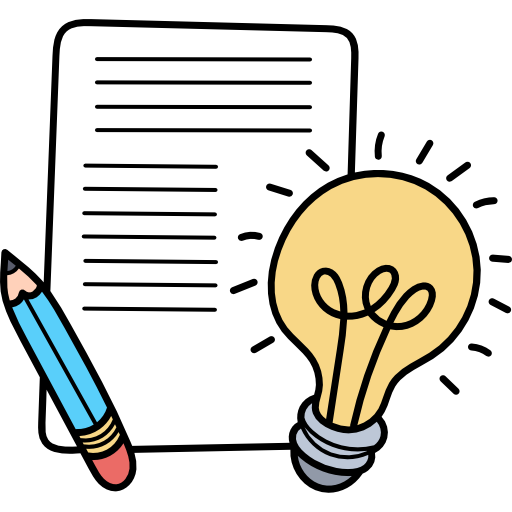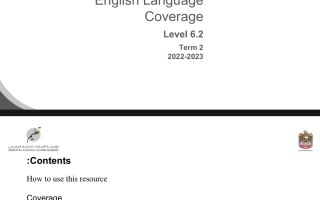بوربوينت قواعد ووظائف نهاية الفصل الثاني اللغة الإنجليزية الصف الثامن Elite
The Coverage, Grammar and Functional Language Teaching Resource
The slides within this resource, although detailed, are designed to be used as a starting point for teachers to construct lessons around the language points that are explored here. The slides are intended to be used individually as a resource within a lesson and to be incorporated as part of instruction incrementally throughout the term to ensure that students have been exposed to all the language points in the mverage ahead of their end of term exam. Therefore. the PowerPoint should not be presented at a single event or in its entirety. Some functional language points may overlap with grammatical points in the coverage, and in that case, it is possible to combine slides. However, this resource should be
considered to be a collection of individual slides that teachers can use to enhance stucknts' learning
Within this document, you will find information about the coverage for this term. The lexis family that assessrnents will contain is mentioned as well as the particular grarnmatical and functional language points that will be tested in the exams at the end of this terrn. In the preparation sections, you will find examples and explanations for the grammatical and functional language points that will be assessed this term
The grammar preparation section has an example sentence that illustrates the grammatical point. It follows this with an explanation of the meaning of the example sentence. Next, the specific grammatical structure used within the example sentence is detailed followed by an explanation of the circumstances under whidl the particular structure is used. More example sentences using the structure are given at the end of the slide. In the functional language preparation section. there are examples of the particular language point followed by an explanation of how the particular are used. In the associated grammar section, language points that comprise the structure or can be used to in conjunction with the language
Ahmed ran faster and faster towards the end of the race
Meaning The example explains that the boys speed increased as he got closer to the finish of the race
Grammatical structure Comparative adjectives
comparative adjective-er + and + comparative adjective-er
Usage We can use repeated comparative adjectives to highlight the rate of or amount of change in something. This can be sornething that is increasing or decreasing
Other examples Salim is eating too much fast food. He'S getting
The number of people who read printed books is getting smaller and smaller
The university entry exams are becoming harder and harder to pass
The harder you practise playing tennis, the better you 'II be
Meaning The example explains that if you work hard at something such as tennis, you will improve at it
Grammatical structure Comparative adjectives
the' + comparative adjective + clause 1 + 'the' + convarative adjective + clause 2
Usage We can use comparative adjectives with the' to show how one thing depends on another. They describe how if a person or thing gains more of a particular quality. this causes an increase of another quality. Comparative adjectives of words with one (or two when the word ends in y) syllables are formed by adding the suffix —er. Comparatives of longer adjectives are formed by adding more' or 'less' before the adjective
Other examples The -faster you walk. the esmngr you' II get there
The -bigger the TV, the more it is
The _older the boy got, the taller he became
Meaning Someone selects a different football team to take part in a competition every few months
Grammatical structure Passives
object + 'to be' + past participle + time phrase (present simple passive)
object + will / going to + be + past participle + time phrase (future simple passive)
object + was I were + past participle + time phrase (past simple passive)
Usage Factitive verbs such as 'appoint, build, paint, make, choose, think and find' can be used to show a change of state. They are used in the passive voice as the focus is on the action being described rather than on who or what is performing the action. To use the passive voice, the object of the active sentence is moved into the subject position. A range of tenses can be used
Other examples The sports stadium in three years. (future simple passive)
The picture 'A'as painted over 100 years ago. (past simple passive)
Are they going to be invited to the event next week ? (future simple passive)
very day in order to stay fit and healthy
Meaning The person is explaining the reason why they go to the gym
Grammatical structure Conjunctions: subordinating
clause + 'in order to / so as to' + verb (infinitive)
Usage We can use subordinating conjunctions with 'in order to / so as to' to describe purpose and intention. These conjunctive phrases are positioned at the beginning of a dependent clause. They link it to an independent dause and without them, the sentence would not make sense
Other examples I usually walk to most places save money
She practiced hard in order to pass the test
In order to win the game, we had to beat a much stronger team
Meaning The statement emphasises the amount of rainfall over a period of time
Grammatical structure Adverbs and determiners of degree
so' + adjective / adverb
such I such a' + noun I adjective + noun phrase
Usage An adverb or determiner of degree tells us how strong or intense something is, or the amount of They are usually placed before the adverb, adjective, or noun that they modify. If an uncountable noun that is modified, such' is used. If a countable noun is modified, 'such a' is used
Other examples It's so hot today
It's such a long time until our next holiday
We had sycb fun at the theme park
the new gym when it opens
Meaning The subject is talking about a future plan in the present continuous tense
Grammatical structure Present time: present simple or present continuous
'mean I intend I plan to' + verb phrase (infinitive)
Usage The present simple or present continuous tenses can be used with •mean / intend / plan to' Wth a verb phrase and infinitive to express future plans or intentions
Other examples Do you join the school art dasses ? (present simple)
I do that as soon as possible. (present simple)
They are intending _to go to the park later. (present continuous)



